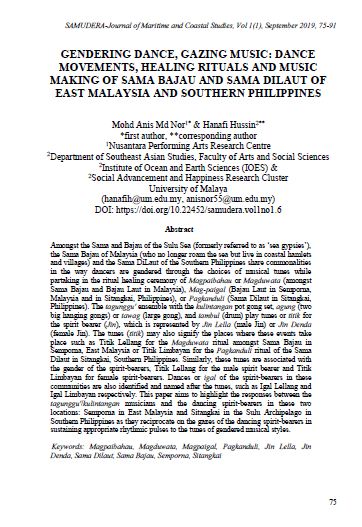GENDERING DANCE, GAZING MUSIC: DANCE MOVEMENTS, HEALING RITUALS AND MUSIC MAKING OF SAMA BAJAU AND SAMA DILAUT OF EAST MALAYSIA AND SOUTHERN PHILIPPINES
Main Article Content
Abstract
Amongst the Sama and Bajau of the Sulu Sea (formerly referred to as ‘sea gypsies’), the Sama Bajau of Malaysia (who no longer roam the sea but live in coastal hamlets and villages) and the Sama DiLaut of the Southern Philippines share commonalities in the way dancers are gendered through the choices of musical tunes while partaking in the ritual healing ceremony of Magpaibahau or Magduwata (amongst Sama Bajau and Bajau Laut in Malaysia), Mag-paigal (Bajau Laut in Semporna, Malaysia and in Sitangkai, Philippines), or Pagkanduli (Sama Dilaut in Sitangkai, Philippines). The tagunggu' ensemble with the kulintangan pot gong set, agung (two big hanging gongs) or tawag (large gong), and tambul (drum) play tunes or titik for the spirit bearer (Jin), which is represented by Jin Lella (male Jin) or Jin Denda (female Jin). The tunes (titik) may also signify the places where these events take place such as Titik Lellang for the Magduwata ritual amongst Sama Bajau in Semporna, East Malaysia or Titik Limbayan for the Pagkanduli ritual of the Sama Dilaut in Sitangkai, Southern Philippines. Similarly, these tunes are associated with the gender of the spirit-bearers, Titik Lellang for the male spirit bearer and Titik Limbayan for female spirit-bearers. Dances or igal of the spirit-bearers in these communities are also identified and named after the tunes, such as Igal Lellang and Igal Limbayan respectively. This paper aims to highlight the responses between the tagunggu'/kulintangan musicians and the dancing spirit-bearers in these two locations: Semporna in East Malaysia and Sitangkai in the Sulu Archipelago in Southern Philippines as they reciprocate on the gazes of the dancing spirit-bearers in sustaining appropriate rhythmic pulses to the tunes of gendered musical styles.
Downloads
Article Details
References
Bottignolo, B. (1996). Celebrations with the sun: An overview of religious phenomena among the Badjaos. Quezon City: Ateneo de Manila Press.
Fernando, S. (2002). Tagunggu practice by the Bajau of Semporna, Sabah. Tirai Panggung, 5, 17-29.
Hussin, H. (2004). Field Notes September 17-19, 2004. Research on Magduwata in Kampung Kabimbangan Tengah, Bum Bum Island, Semporna, Sabah.
Hussin, H. (2005). Field Notes January 8-9, 2005. Research on Magduwata in Kampung Kabimbangan Tengah, Bumbum Island, Semporna, Sabah.
Hussin, H. (2009). Diaspora Bajau Laut dan pengekalan serta penerusan amalan tradisi di Sabah (Bajau Laut’s Diaspora and preservation of their traditional practices in Sabah). Borneo Research Journal, 2,149-163.
Hussin, H., & Santamaria, MCM. (2008). Dancing with the ghost: Experiencing the Pagkanduli ritual of Sama Dilaut (Bajau Laut) in Sikulan, Tawi-Tawi, Southern, Philippines. JATI (Journal of Southeast Asian Studies), 13, 159-172.
King, V. T. (1993). The peoples of Borneo. Oxford: Blackwell Publishers.
Md Nor, M. A., & Hussin, H. (10-17 July 2006). Mag-igal and Igal-Jin: Dancing the spirits of the ancestors in the rituals of Magduwata of the Bajau Kubang in Bumbum Island, Semporna, East Malaysia. Paper presented at 24th Ethnochoreology International Symposium, Cluj, Romania.
Md Nor, M. A., & Hussin, H. (April 7 2007). Mag-igal and Igal-Jin of Bajau Kubang: Invoking liminality for the spirits of the ancestors in Semporna, Sabah. Paper presented at the Conference on Shamans and Spirit Mediums, Asian Civilization Museum Singapore, Singapore.
Md. Nor, M.A. (2003). Arabesques and curvilinear perimeters in the aesthetics of maritime-Malay dances. 2003 Yearbook for Traditional Music, International Council for Traditional Music, 35, 179-181.
Md. Nor, M.A. (2005). Field Notes January 8-9, 2005. Research on Magduwata in Kampung Kabimbangan Tengah, Bumbum Island, Semporna, Sabah.
Pugh Kitingan, J., Hussin, H., & Baptist, J.J (2005). Dance as ritual, dance as celebration– Tradition and change amongst the Bajau of Semporna, Sabah, Malaysia. In M.A. Md Nor & R. Murugappan, Global and Local Dance in Performance (207–219). Kuala Lumpur: Cultural Centre, University of Malaya & Ministry of Culture, Arts and Heritage Malaysia.
Sather, C. (1997). The Bajau Laut: Adaptation, history, and fate in a maritime fishing society of South-Eastern Sabah. New York; Kuala Lumpur; Singapore: Oxford University Press.
Sather, C. (2000). Bajau Laut boat building in Semporna. Techniques & Culture, 35-36, 177-198.
Sather, C. (2004). Keeping the peace in an island world of violence: Sama Dilaut ways of managing conflict. In A. R. Walker, Leadership, justice and politics at the grassroots (pp. 127-158). Contributions to Southeast Asian Ethnoghraphy, No.12: 131.
Walton, J. R., & Moody, D. C.(1984). The East Coast Bajau Languages. In J.K. King & J. W. King, Languages of Sabah. A Survey Report (pp. 114-119). Pacific Linguistics Series C, No. 78. Canberra: Australian National University, 1984 reprtd.1997
